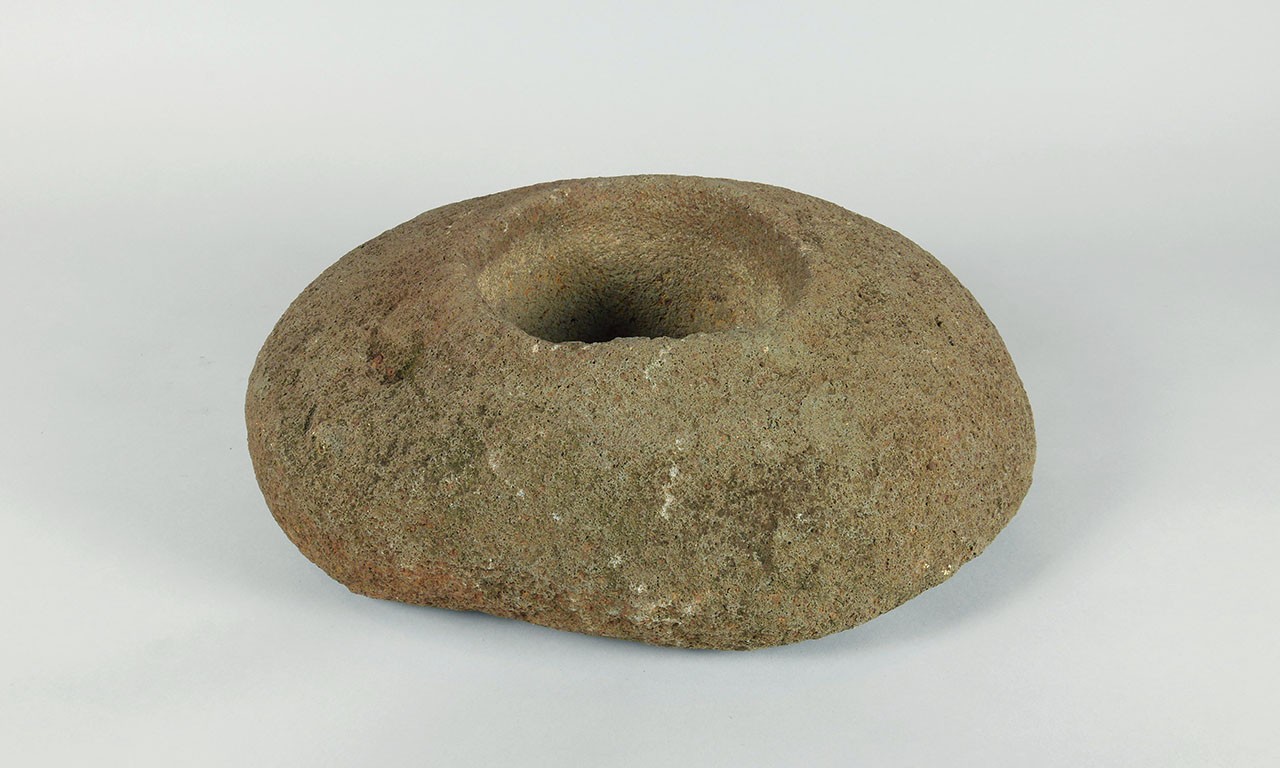 |
Ritual Mortar
Siassi Island, Morobe Province, Papua New Guinea, Melanesia
Stone; 6 5/8 × 19 × 15 in.
2011.11.7
Collected on behalf of the Bowers Museum by the Roski-Keller-Martin Expeditions 2000-2008 |
Neo-Prolific
The earliest archeological evidence shows humans migrated to the world’s second largest island, Papua New Guinea, at least 50,000 years ago. The relatively low water levels of an ice age made it possible to walk and sail short distances to move between the continental shelves of Asia and Australia—the latter of which New Guinea was at the time connected to. The warming of our current Holocene era caused sea levels to rise and plunged these routes into the Pacific and Indian Oceans. The Holocene’s milder climates also led to an agricultural revolution which took place around the world. Between 10,000 and 7,000 years ago there is evidence of the first taro and bananas being cultivated in the highlands of New Guinea. The new sedentary lifestyle spurred the development of new tools and a neolithic era in Melanesia. The objects in this post were made after thousands of years had passed but still hundreds or thousands of years before the modern day, they represent some of the oldest existing sculptural artifacts from Oceania.

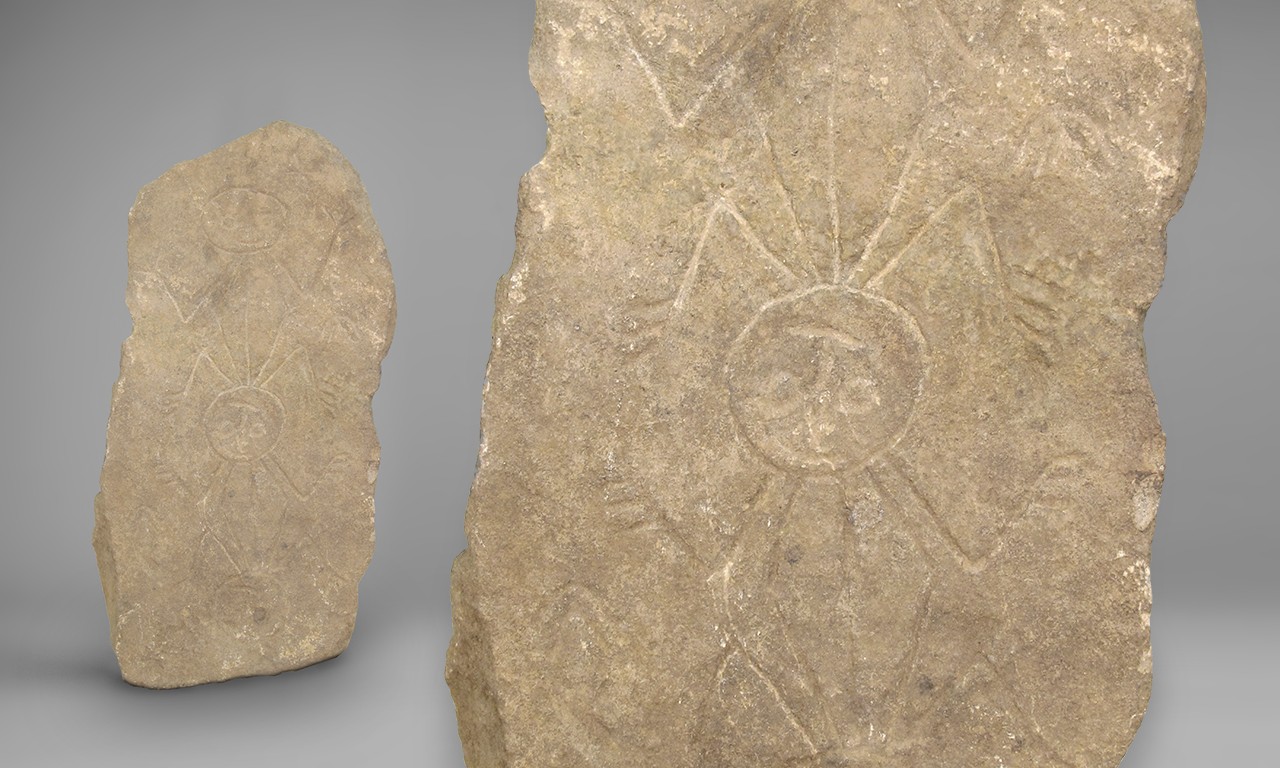 |
Petroglyph
Gaua Island, Banks Islands, Torba Province, Vanuatu, Melanesia
Stone; 6 1/2 × 2 1/2 × 1 1/4 in.
2017.10.138
Anonymous Gift |
Rock Art, Stick Figures
Engraved petroglyphs such the carving on this stone are among the earliest arts to come out of Melanesia. Under appropriate environmental conditions, such as those found in the arid, wind-protected environs of caves, stone carvings and paintings can survive tens of thousands of years. Little is known about this particular stone except that it was collected on Gaua Island, the second largest of Vanuatu’s Banks Islands. The carving is incredibly unique, its subject depicted along a vertical axis with three heads, one each at both ends and the third in its center. Two bodies connect the heads from which two sets of arms and legs protrude. Examples of very similar cave engravings of anthropomorphic figures with bent arms and legs, circular heads, and lozenge-shaped bodies have been found in sites throughout Vanuatu, but this totemic arrangement has not been seen elsewhere.

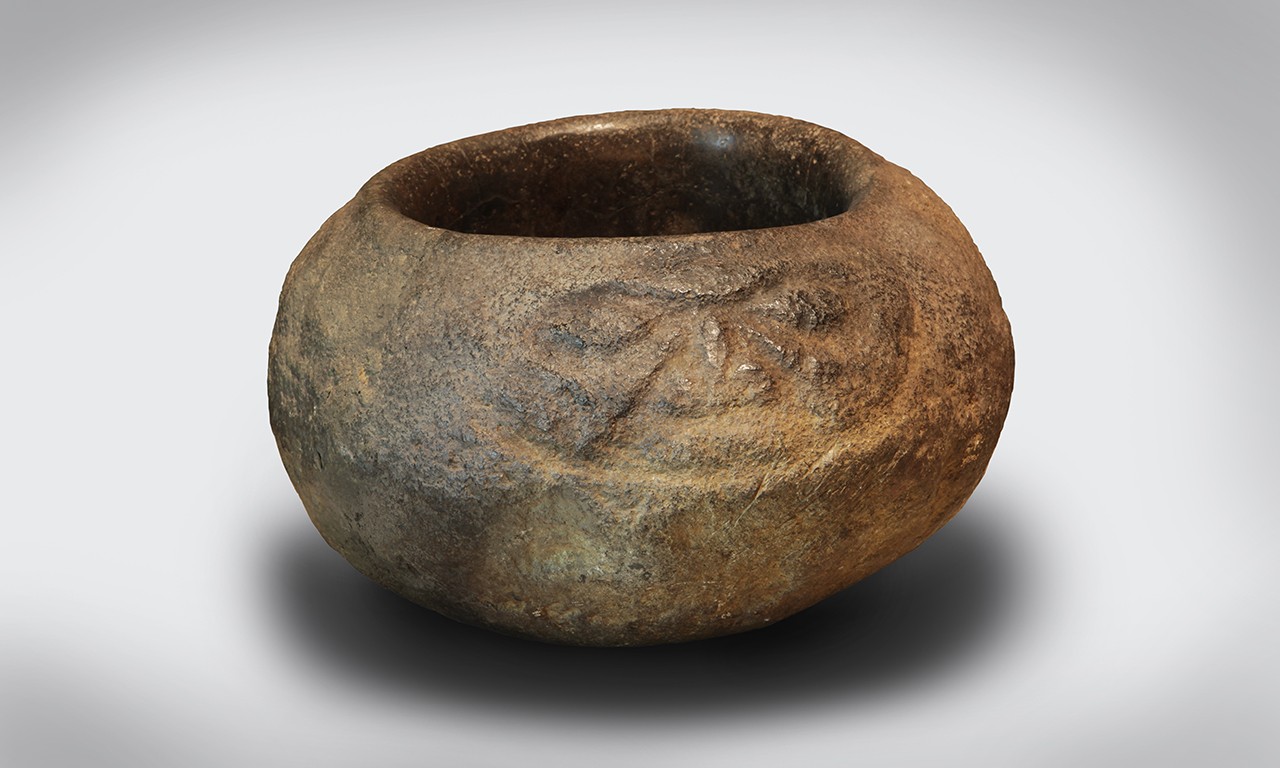 |
Mortar with Human Face
Enga Province, Papua New Guinea, Melanesia
Stone; 7 1/2 × 14 in.
2003.49.1
Gift of Anne and Long Shung Shih |
High- and Mortar-Ground
Decorated stone bowls and mortars found in the Highland Region of Papua New Guinea are the earliest known examples of sculptures throughout the entire Oceanic region. The smaller of the two mortars featured in this post is likely thousands of years old. It is immensely dense, weighing approximately 60 pounds. The outer surface is rough in texture and is void of any decoration except for a single stylized human face under the rim of the bowl. The interior of the bowl is very smooth, dark in color and is deeply recessed, undoubtedly from the repeated grinding of a pestle. Though the role of these mortars in food preparation is a given, theories suggest that they may have been multi-purpose in function: doubling as reflective basins, serving as dishes, or used to grind minerals and medicines.
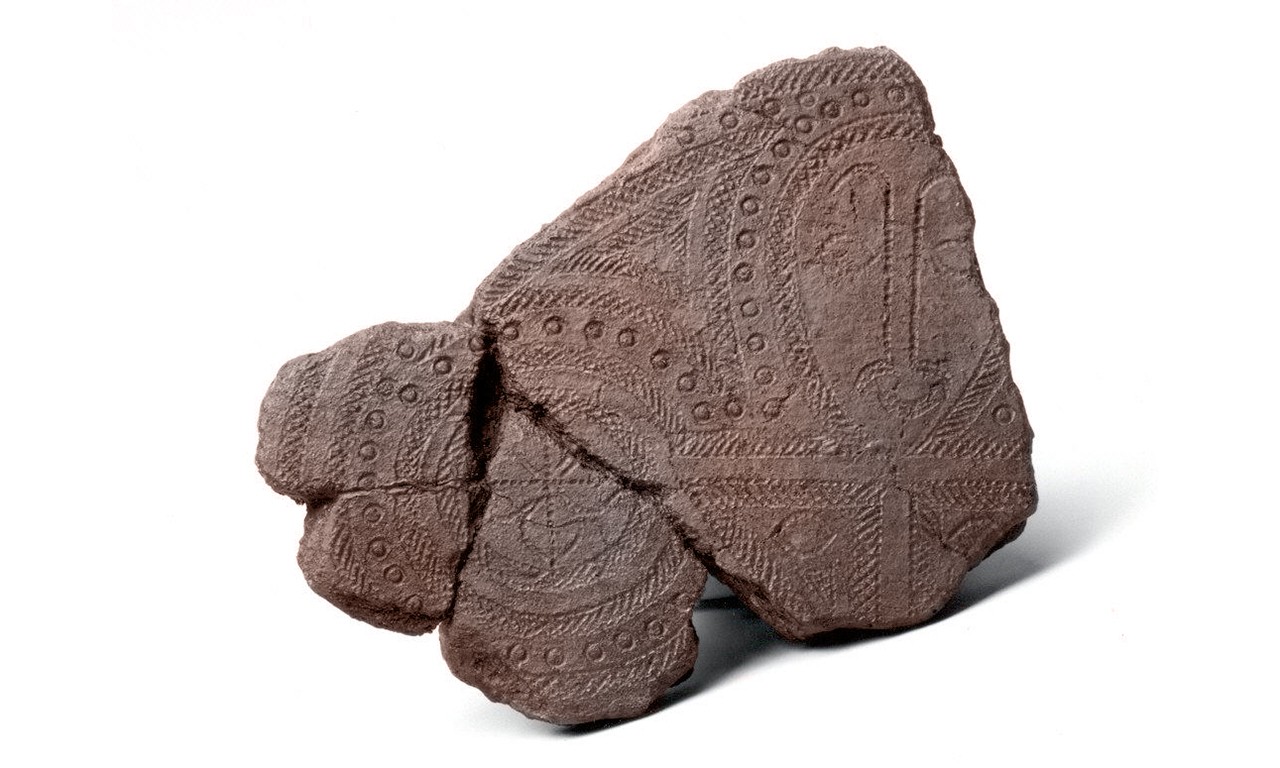 |
| Cast of a Lapita pottery sherd, Metropolitan Museum of Art |
Surefired Expansion
Perhaps the most famous archaeological objects to come from Oceania are Lapita pottery. Around 3,500 years ago a culture that we now call the Lapita came to Melanesia and from there began to expand outward with outrigger canoes and ocean wayfinding to populate the islands of Micronesia and Polynesia. Among other technologies available to the Lapita, they were expert ceramicists who used stamps to create intricate designs in the wet clay of vessels before they were fired. Examples of Lapita pottery can be found throughout Oceania and serve as evidence for the current theory of the peopling of the region. When the Bowers Museum’s Spirits and Headhunters exhibition first opened, several examples of Lapita pottery were temporarily displayed on loan from the Bishop Museum—one of the largest repositories of Lapita pottery in the world.

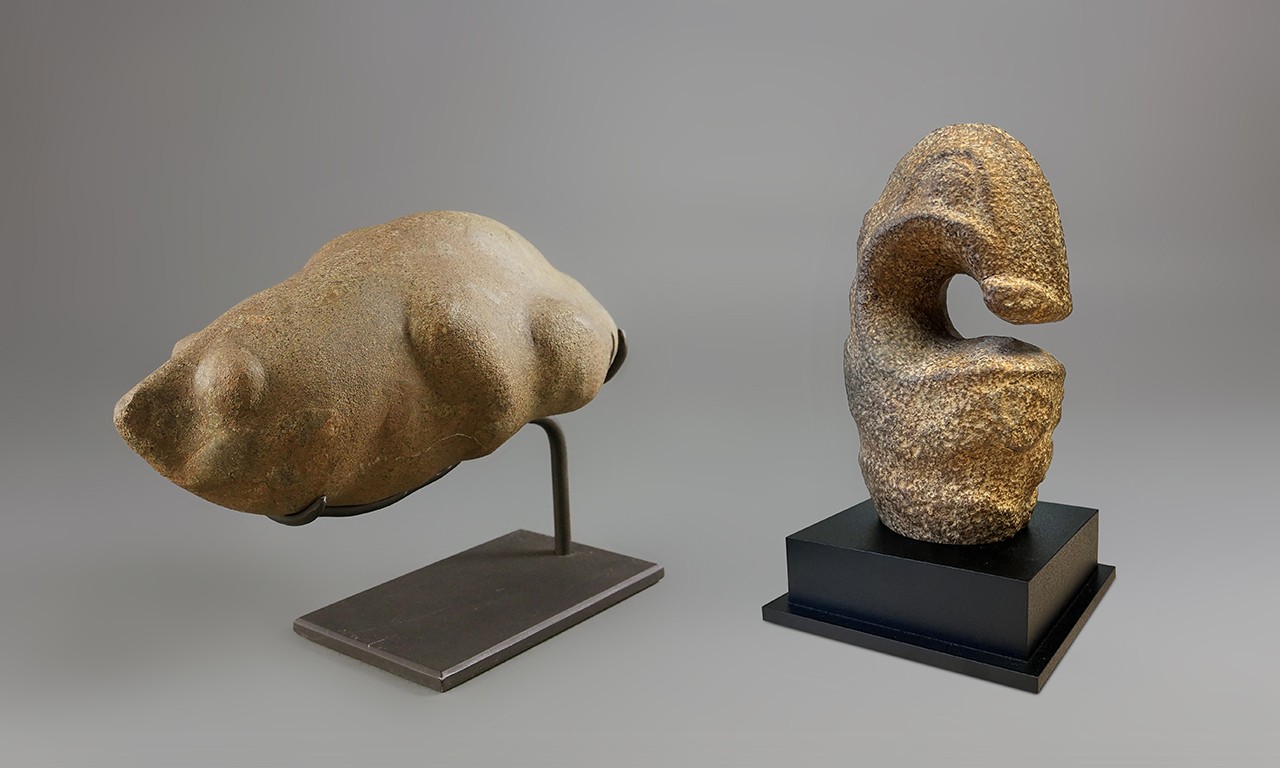 |
Marsupial Figure
Laiagam Valley, Central Enga Province, Papua New Guinea, Melanesia
Stone; 3 1/2 × 3 1/2 × 7 1/2 in.
2019.8.1
Bowers Museum Purchase |
Possibly Echidna Figure
Laiagam Valley, Central Enga Province, Papua New Guinea, Melanesia
Stone; 6 1/2 × 3 1/4 × 2 1/4 in.
L.2022.4.9
Anonymous Loan |
Enga Echidna
Another important archeological datapoint are the stone effigies that have been rediscovered in the Enga Province of Papua New Guinea. The Bowers Blog previously wrote about a recently acquired example of this in Out of the Pouch: Shedding Light on a Papuan Marsupial Figure. An upcoming loan to the Bowers illustrates a different form of a similar object type, in this case a stone which appears to be incredibly similar to one of the most famous pieces of Oceanic art in existence: the National Gallery of Australia’s Ambum stone. It is a pestle of incredible craftsmanship pecked into the form of an echidna or a mythological creature. Due to organic material found in a crack in another similar example, Enga Province effigies have been carbon dated to about 3,500 years ago. Stones such as these form bridges between prehistory and traditional Papuan societies in the 20th century. When ancient relics such as these were rediscovered thousands of years after their creation, they tended to become ritual objects. The Ambum stone, for example, was used as a fertility icon.
Text and images may be under copyright. Please contact Collection Department for permission to use. References are available on request. Information subject to change upon further research.






Comments